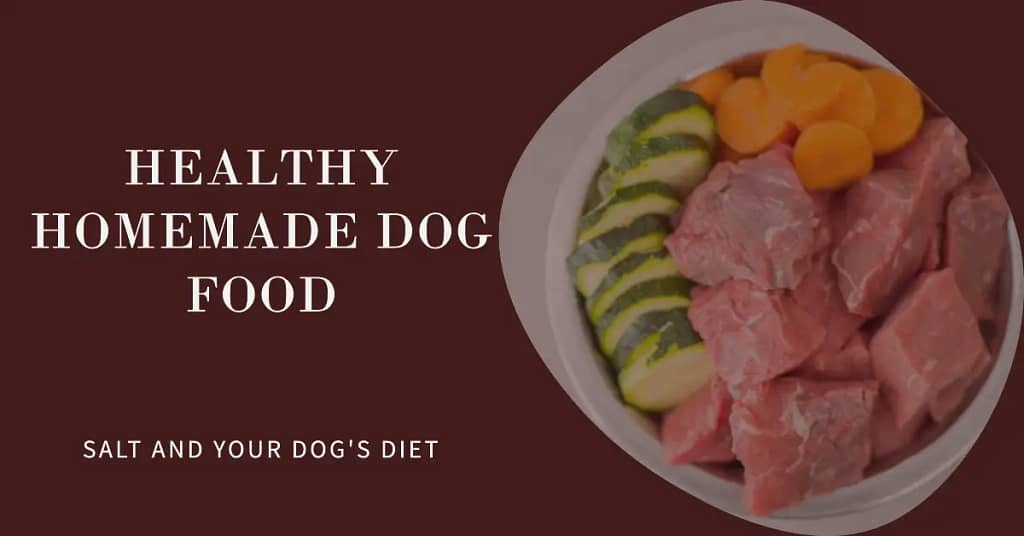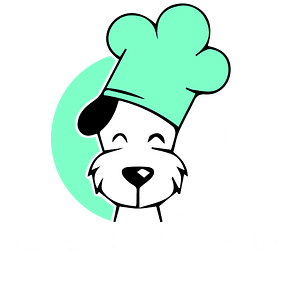Dogs need salt in their diet because it is necessary for their body, but in a certain amount, 0.25–1.5 g per 100g. A certain amount of salt is healthy for dogs and helps them maintain their cellular functions, like fluid and acid-based. A certain amount of salt in homemade dog food is good for dogs. It helps them keep their bodies.

Table of Contents
ToggleWhy use Salt in Homemade Dog Food?
In both people and dogs, salt is an essential element that supports a variety of body processes. A moderate amount of salt added to homemade dog chow has different benefits.
Salt aids in keeping your dog’s body’s electrolyte balance, which promotes healthy neuron and muscle function.
Increased Appetite:
A dash of salt can improve the flavor of the homemade foods you give your dog, making them more palatable.Some nutrients are absorbed by adequate salt levels, which optimizes your dog’s overall nutrient intake.
How much should I use salt in homemade dog food?
Creating homemade dog food can be a rewarding way to ensure your furry friend is getting the best nutrition possible. One essential aspect of salt in homemade dog food is determining the right amount of salt to use. Salt is a critical mineral that plays a role in various bodily functions for dogs, much like it does for humans.
However, it’s crucial to strike a balance because both too much and too little salt can be harmful to your canine companion.The recommended amount of salt in homemade dog food varies depending on factors such as your dog’s size, age, and overall health. A general guideline is to use about 0.25% to 0.5% by weight of salt in a homemade dog food recipe.
To calculate this, you can weigh the total amount of food you’re preparing and then add the appropriate amount of salt within this range.It’s important to consult with your veterinarian before introducing any changes to your dog’s diet, including adjusting salt levels. They can provide personalized advice based on your dog’s specific needs and dietary restrictions.
Keep in mind that some commercial dog foods already contain sufficient salt, so supplementing it in homemade meals may not always be necessary.Remember that moderation is key when adding salt to homemade dog food. Too much salt can lead to health issues like dehydration and high blood pressure in dogs.
On the other hand, too little salt can result in an unpalatable meal that your dog may not want to eat. Striking the right balance will help ensure your homemade dog food is not only nutritious but also enjoyable for your furry companion.
Benefits of Using Salt in Homemade Dog Food:
There are several advantages to using salt in homemade dog food, including:
Support for Hydration: Salt makes your dog want to drink more water, which helps with hydration and digestion.
Nutritional Balance: By aiding in the absorption of vital nutrients, salt helps to maintain a balanced diet.
A hint of salt can improve the flavor of home-cooked food and entice finicky eaters to consume their food.
Which foods are too salty for a dog’s diet?
Salt gives just a test in foods to make them delicious. If you want to give your dog a certain amount of salt in their diet and make them healthy, you must avoid these items that contain too much salt in homemade dog food. These are some foods that contain too much salt.
● Crisps
● Savory biscuits
● sausages
● burgers
● Chips
● Cheese
Safe Amounts of Salt In Homemade Dog Food
When it comes to preparing homemade dog food, it’s essential to ensure that your furry friend’s diet is not only delicious but also safe and nutritious. One often-overlooked ingredient in recipes for homemade dog food is salt. While salt is a common seasoning in human meals, its use in dog food requires careful consideration.
Dogs, like humans, need a certain amount of sodium for their bodies to function correctly. However, excessive salt intake can lead to health issues in dogs, such as dehydration and kidney problems. So, what are the safe amounts of salt in homemade dog food?
The ideal sodium intake for dogs can vary depending on their size, age, and overall health. As a general guideline, a healthy adult dog should consume no more than 0.5 to 1.5 grams of salt per 100 grams of food. Puppies and senior dogs may have different requirements, so it’s best to consult with your veterinarian to determine the precise salt needs for your individual pet.
To ensure your homemade dog food is safe and balanced, start by selecting high-quality, low-sodium ingredients. Opt for fresh meats, vegetables, and grains, and avoid adding additional salt during the cooking process. Natural sources of sodium, like those found in meat, can provide the necessary amount for your dog’s diet.
If you’re using store-bought broth or stock, always choose low-sodium options or make your own to have better control over the salt content.Remember that moderation is key when it comes to salt in your dog’s diet. Excessive salt can lead to sodium ion poisoning, a potentially life-threatening condition in dogs. Symptoms include vomiting, diarrhea, excessive thirst, and lethargy.
To ensure your homemade dog food is safe and healthy, consult with your veterinarian to create a customized diet plan tailored to your dog’s specific needs. Your vet can provide guidance on the right amount of salt and other essential nutrients to keep your canine companion happy and healthy.
The minimum amount of salt intake daily for dogs should be around 13 mg/kg of body weight, which is about 0.2 g/1000 kcal. The 0.2 g/1000 kcal amount of salt in dog food is not dangerous and helps them grow correctly.
Are there any risks associated with using salt in homemade dog food?
Many pet owners are increasingly concerned about the quality of the food they provide for their furry companions, leading them to consider homemade dog food as a healthier alternative to commercial options. While salt in homemade dog food offers several benefits, such as customization and the use of fresh ingredients, there are important considerations to keep in mind, one of which is the use of salt.
Salt is a common seasoning in human food, but its role in a dog’s diet is different. While it’s true that dogs need a certain amount of sodium for their bodies to function properly, excessive salt intake can lead to health problems. Too much salt can result in high blood pressure, which can then contribute to heart disease, kidney issues, and other serious health conditions in dogs.
One of the key risks associated with using salt in homemade dog food is the difficulty of controlling the amount used. Unlike commercial dog food, where the sodium content is regulated, homemade recipes often leave salt quantities up to the discretion of the pet owner. This lack of precision can lead to unintentional overuse of salt, putting your dog’s health at risk.
Furthermore, some dogs are more sensitive to salt than others. Breeds like Labrador Retrievers and Golden Retrievers are more prone to salt-related health issues, so it’s essential to be cautious when incorporating salt in homemade dog food.
To mitigate the risks, consult with your veterinarian when planning your dog’s homemade diet. They can provide guidance on the appropriate amount of salt to use based on your dog’s age, size, and overall health. Opt for natural, unprocessed salts like sea salt or Himalayan salt, as they contain trace minerals that can be beneficial in moderation.
Salt in homemade dog food should be used sparingly and with careful consideration of your dog’s specific needs. Your dog’s well-being should always be the top priority, so consult with your veterinarian and strike a balance between taste and health when preparing homemade meals for your furry friend.
The risks associated with using salt in homemade dog food while emphasizing the importance of consulting with a veterinarian for a balanced and healthy diet for your pet.
Recipes Utilizing Salt in Homemade Dog Food:
Chicken and Rice Delight:
- Boiled chicken breast
- Cooked brown rice
- Steamed carrots
- A pinch of salt
Beef and Sweet Potato Stew:
- Lean ground beef
- Mashed sweet potatoes
- Peas
- A touch of salt
Tips for Using Salt in Homemade Dog Food:
Title: Tips for Using Salt in Homemade Dog Food
When it comes to preparing homemade dog food, ensuring your furry friend gets the right balance of nutrients is crucial. Salt, while a common seasoning in human cuisine, requires special attention when adding it to your dog’s meals. Here are some essential tips to keep in mind when incorporating salt into homemade dog food.
1. Moderation is key.
Just like in our own diets, moderation is vital. Dogs need a small amount of salt for various bodily functions, but too much can be harmful. As a general guideline, aim for about 0.25% to 0.5% salt content in your dog’s homemade food.
2. Use sea salt or Himalayan salt.
When choosing a type of salt, opt for natural options like sea salt or Himalayan salt. These varieties contain valuable minerals that can benefit your dog’s health. Avoid using table salt, which often contains additives like iodine and anti-caking agents.
3. Consult your vet:
It’s always a good idea to consult your veterinarian before making any significant changes to your dog’s diet. They can provide specific recommendations based on your dog’s breed, size, age, and health conditions.
4. Consider SpecialDiets:
If your dog has specific dietary requirements or health issues, such as kidney problems, consult with your vet to determine if salt should be limited or excluded from their homemade meals.
5.Homemade Treats:
If you’re making homemade dog treats, be mindful of the salt content. Many dog treat recipes can be adapted to reduce or eliminate salt without compromising flavor.
6. Monitor sodium levels:
Keep an eye on your dog’s overall sodium intake, which includes salt from both commercial dog food and homemade meals. Balancing their sodium intake is crucial for their well-being.
7.Gradual Introductions:
If you’re introducing salt to homemade dog food for the first time, do it gradually. This allows their system to adjust and ensures they don’t have any adverse reactions.
8.Read Labels:
f you use commercial dog food as part of your dog’s diet, read the labels carefully. Some commercial dog foods already contain a significant amount of sodium, so you may need to adjust the salt in homemade dog food accordingly.
Salt can be a beneficial part of your dog’s diet when used in moderation and with careful consideration. Always prioritize your dog’s health and consult with a veterinarian for personalized advice. By following these tips, you can ensure that your homemade dog food is both tasty and nutritious for your canine companion.
So how much salt is too much?
Title: How Much Salt Is Too Much for Dogs?
Salt is a common ingredient in many human foods, but have you ever wondered how much salt is safe for your furry friend? While salt is essential for a dog’s diet, too much of it can lead to serious health problems.
The recommended daily salt intake for dogs varies depending on their size, but as a general guideline, most veterinarians suggest no more than 100 milligrams of sodium per pound of body weight per day. This means that for an average-sized dog, around 50 pounds, their daily sodium intake should not exceed 5,000 mmilligrams,or 5 grams.
Excess salt consumption can lead to conditions such as salt poisoning or hypernatremia in dogs. Symptoms of salt poisoning include excessive thirst, vomiting, diarrhea, lethargy, tremors, seizures, and even death if left untreated. It’s important to be mindful of the salt content in your dog’s diet, especially when feeding them human foods.
Many processed and salty snacks, like chips or pretzels, should be kept far away from your canine companion, as they can quickly surpass their daily sodium limit.To ensure your dog’s well-being, always check the salt content of any treats or food you’re considering giving them. Opt for dog-specific treats and avoid sharing your salty snacks.
If you’re concerned about your dog’s salt intake or suspect they may have consumed too much salt, consult your veterinarian immediately. They can provide guidance on managing the situation and help you make informed choices about your dog’s diet to keep them happy and healthy. Remember, a little salt is fine, but too much can be harmful, so moderation is key when it comes to your dog’s salt intake.
Nutrient Salt is not bad for all dogs. It’s about moderation – just like us humans. A certain amount of salt, 0.25g – 1.5g per 100g, is not badfor dogs. If you want to see your dog healthy, you must avoid too many salty foods like crisps, cheese, chips, and others. But puppies are too sensitive, so you cannot give them 0.25g – 1.5g per 100g of salt.
Finding out how much salt is in your dog food
As a result of sodium and chloride, salt has a salty taste. Sodium and chloride percentages should be checked before buying dog food. The percentage of sodium and chloride is printed on the back of the dog food box. An adult dog needs a minimum amount of 0.12% chloride and 0.08% sodium in their food.
Can Dogs Eat Salty Food?
The best action method is to stay clear of giving your dog meals that are heavy in salt, even though an occasional taste may not be harmful. If taken frequently, processed and salty human foods like chips, pretzels, and cured meats can cause health issues in dogs. If you give your dog a bit of a salty treat, make sure it happens seldom and that the item has a low salt level.
Is salt good for dogs every day?
Dog salt is an essential part of your dog’s health. It is an important ingredient in dog food but in a minimum amount. It helps keep the body balance and plays a role in nerve function. But too much salt causes many health problems and can lead to salt toxicosis.
Conclusion :
The conclusion is that salt plays an important role in dog life. Muscle and nerve function are both affected by its presence. It also helps to replenish their electrolytes. It means that salt plays an essential role in dog life. So we can give salt in homemade dog food but in certain amounts, 0.25g – 1.5g per 100g. If you want to see your dog healthy, you must not give them salty food because they cause several problems. Food that is too salty causes many problems and health issues.
These Are some foods that contain too much saltCrisps, Savory biscuits, sausages, burgers, Chips, Cheese, and many others. Giving dogs too much salty food causes many health issues like Dehydration, High blood pressure, and Sodium ion poisoning.
Dehydration:
Excess amounts of salt in the body cause dehydration. Serval dehydration causes lethargy, confusion, and many other neurological effects. Your dog might also cause these diseases like muscle cramps and joint stiffness.
High blood pressure:
High salt levels in your dog’s blood can lead to hypernatremia and high blood pressure. If your dog has naturally High blood pressure, you don’t feed them salty food.
Sodium ion poisoning:
If your dog consumes many salty snacks, it can increase the amount of sodium in its body. An extreme sodium level in the blood causes salt toxicity or sodium ion poisoning. This condition can
cause severe heart attack and, in some cases, death. If your dog shows these signs of sodium ion poisoning, you should see the doctor immediately.

